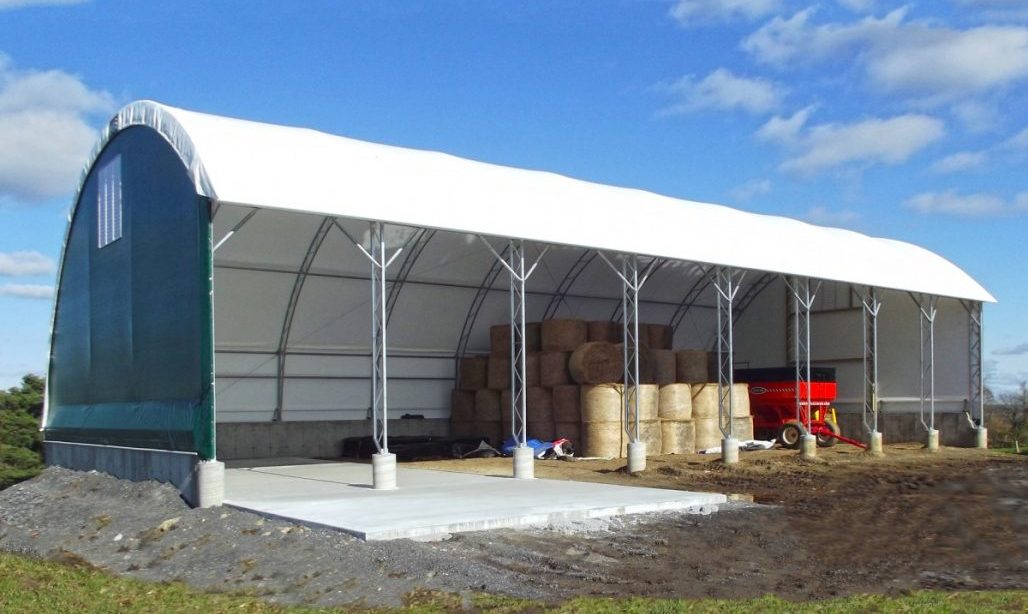By: Robert Lee
In the 1970s, rural North America began seeing a proliferation of saddle-back barns – the old hips roof barns that had reached their 30–50-year lifespan and the trusses had given way, sagging in the middle like a saddle. In the 1990s, we saw the invasion of sagging Quonsets, with the same swayback saddle appearance, as the steel and aluminum corroded and the rivets began to pop. A new design then emerged to replace these antiquated utility buildings: the tension-fabric or poly-fabric structure.
Fabric buildings offer a number of advantages over steel or wood construction, not the least of which are cost and versatility.
Weather
In Canada, the weather presents a huge challenge. In summer, extreme heat and abundant sunlight curl asphalt shingles, dry and crack timber, warp steel. The metals transmit both the heat and the cold, making for significant problems in controlling internal temperature and humidity. Wood rots in a high moisture environment and is often scarce in remote areas, including the north and arid areas of southwest USA. Wind wreaks havoc with the blunt-wall, solid steel or vertical wood wall, and pitched-roof designs. Winter means extreme cold, and, again, steel and asphalt suffer, while concrete cracks and heaves. Poly-fabric, on the other hand, withstands great extremes of temperature, moisture, and other environmental conditions.
Each of the other cited materials used in construction suffers from either corrosion or deterioration in the presence of chemicals, while polymers withstand corrosive materials much better, making the building perfect for applications where salts and other harsh chemicals (including fuels) are present.
Accessibility
The open, curved design of many of the fabric buildings makes them easier to heat, easier to insulate, and less costly to light. Their design, lacking the beams and posts commonly required in large-span metal or wood buildings, is open in order to maximize equipment and storage space.
Lightweight materials allow for less costly transportation to remote sites, reducing far-north or even rural remote construction expenses. These lightweight materials also reduce the need for support infrastructure, which further reduces cost.
One of the inherent advantages of a simple design is simple construction and minimal labour. Fabric buildings rise in a fraction of the time it takes to build metal or wood buildings. This further reduces construction costs.
Maintenance Costs
Maintenance costs of fabric buildings fall when factoring in the need for fewer windows, fewer ventilation requirements, no painting, no replacement of roofing materials, less vulnerability to leaking, and lifespans that exceed wood and asphalt construction, approaches, equals and often exceeds that of even the best quality and thickest gauge of steel.
Fabric Building Misconceptions
One of the occasional “knocks” against polyfabric buildings is that they are made from petroleum products. Therefore some claim the fabric building is less environmentally friendly than wood or metal. That claim is false, however. Polymers used are made from natural gas and waste gas emanating from oil wells, and use, by weight, many times less raw material than any other conventional construction form. While wood may be more “natural” (an odd claim), it deteriorates much more quickly than polymers and therefore multiplies the amount of material consumed than fabric buildings.
Almost always, wood buildings use metal or asphalt roofing. Asphalt, of course, is made directly from crude oil and is far less eco-friendly than the PVC products. Steel and aluminum, both mined metals, are far more malignant in environmental issues than PVC, and are far less eco-friendly. After factoring in the huge savings in actual materials of any sort used in poly-fabric buildings, these structures easily become the environmental choice over metal, and generally are more benign than wood buildings, per square foot.
Cost, versatility, durability, and even environmental friendliness all weigh in favour of the very lightweight fabric structure and make it the ideal choice for a multitude of commercial, industrial, agricultural, and other applications.




